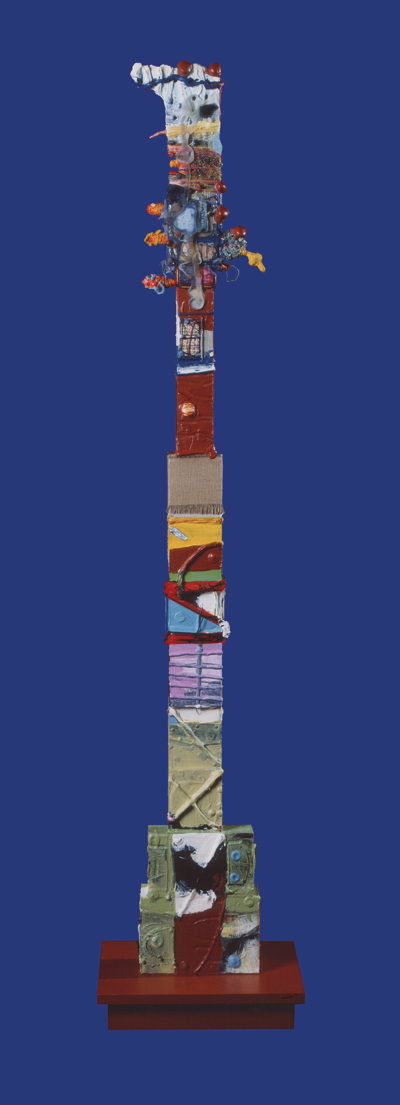
Continuing through September 29, 2013
“I consider process for its own sake. If anything, I am more passionate about an endless pursuit of fragmentation and process.”
- Franklyn Liegel 2010
Los Angeles artist-teacher-mentor Franklyn Liegel passed away suddenly on February 29th of last year. A prominent member of the downtown artist community, this memorial exhibition draws not only from Liegel's body of work, but from a number of fellow artists in a tribute to his active presence here. It also opens up the enormous space his absence creates. His passing elicited an immediate outpouring of grief from former students and friends that was expressed previously in the June, 2012, “Franklyn Calm, Franklyn Excited, Franklyn Artist” at AndrewShire Gallery. The artist's unfinished works, based on the bits and pieces of things found in his studio, were distributed to his students and friends after his passing so those who knew and loved him might continue creating the abstract collage and two-dimensional assemblage works inspired by the late artist.
Liegel taught at Otis, Art Center, USC, the Crossroads School, the Los Angeles County High School for the Arts, and at the New School for Social Research in New York, which presented him with the first annual award for Teaching Excellence in 1988. A dedicated following took his courses term after term and year after year. This exhibition places his contributions as an innovative abstract artist alongside his achievement as a generous teacher.
Born in Wisconsin, Liegel arrived in Los Angeles from Minneapolis where he earned his BFA at the Minneapolis College of Art and Design, enrolling at Otis where he received his MFA in 1977. His downtown studio/loft was located in the Hotel Deluxe on Skid Row. That space served as his home, his studio and the space from which he reached out to the world. He was associated with galleries in Los Angeles, the Koplin Gallery in the eighties and more recently, AndrewShire, and included in group shows around the area. He was a presence as well in Japan, Korea, Costa Rica and New York. William Wilson, Emerson Woelffer, Edward Lucie-Smith and Grace Glueck were among prominent artists and critics who responded to and wrote about his work.
Four works in this show reveal the ever-changing kaleidoscope of abstractions that he drew out of fragments of color and texture. In “Barcelona,” (2006) bright black dots cover a shimmery surface that seemingly “moves” across the shifting colors-beige, rust, blue that open beneath them. Tiny stitches move like ants drawing the eye in and around the clusters of color, of texture that abound. His brand of abstraction kindles a distant but elusive recognition, but of what? Farewell, verisimilitude.
In “Simon Rodia’s Tower” (2006), a tribute to the Watts icon, a pillar of ribbons set against a vibrant blue background flow upward toward a maze of blue, red, aqua color splashes that arrive at an anthropomorphic head of some fantastic animaloid. As always, Liegel resists the quick comparison to the thing we know and recognize. Another tower, “Gaudi’s Tower” (2002), an elegant classical form rises upward in a outburst of color that interprets the famous architect’s love of abundant layers through dizzying color and shapes. The discarded world of bits and pieces, of ribbon, a worked piece of paper painted and worked, textured cardboard, cloth, all come together to form a new vision, an invention of a world not yet formed or named.
In “Recollections of Franklyn Liegel” an essay written for this show, his fellow artist and friend, Ramone Muñoz remembers the thirty or so years he spent with him. Muñoz speaks of Liegel’s uncanny ability to slip into and between the intimate spaces of the string, pressed cardboard, scrim, confetti and bits of prepared paper — the physical elements of his works — and the world that he shared with others:
"From the first day I met him, he seemed to exist in two realities, the real world and the reality of his work which he seemed to produce in a dimension most of us were not privy to, a secret world of bits and pieces of found objects ... He reminded me of Paul Klee, not so much in the appearance of his work, but in his eccentric interaction with people and the world ... He was a true eccentric without any phoniness."
Perhaps it is this duality that provides the model for a memorial that brings together Liegel's work with that of former colleagues and students. Or perhaps Muñoz and Joseph Piasentin, Hei Myung C. Hyun, Kaoru Mansour, Robert Walker, m. Rheuban, and Julienne Johnson simply re-affirm the bonds of silence that bind artists together in a moment and for all time.
Published courtesy of ArtSceneCal ©2013
